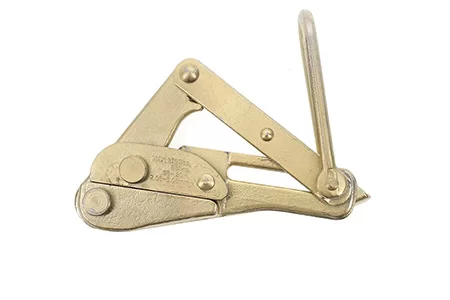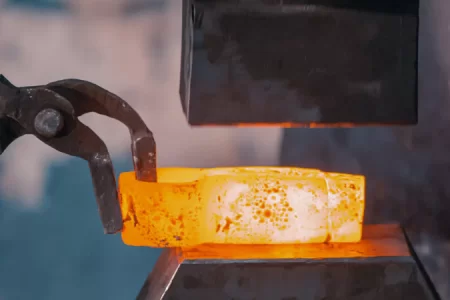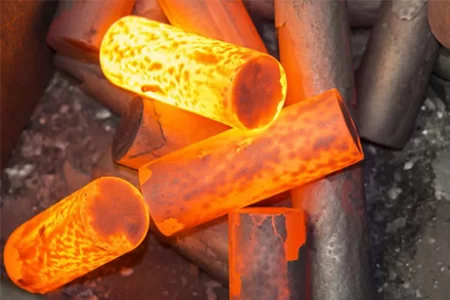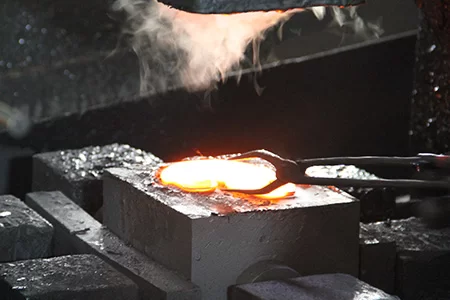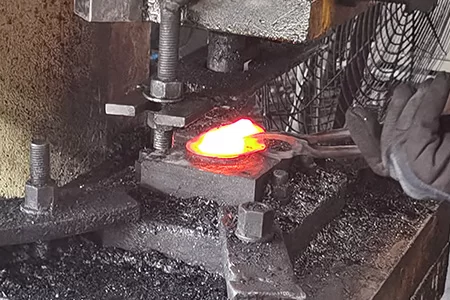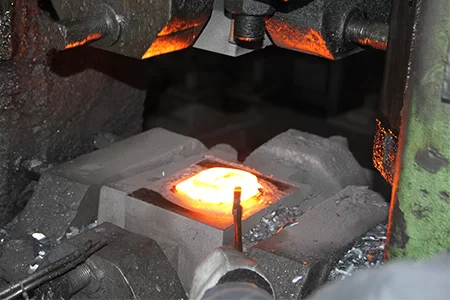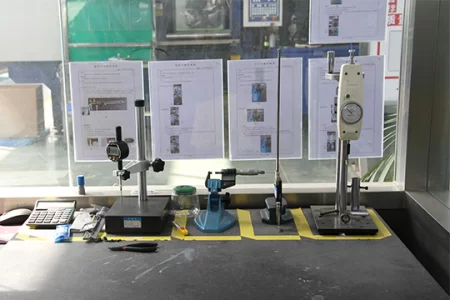By sharing knowledge, experience and views in the field of forging technology, we help you understand, learn and apply relevant technologies.

Hulk Metal Forging Technology
Share technical experience
-
Home>
-
Blog>
-
Technology>
Importance of heat treatment in hot forging

In modern manufacturing, hot forging and heat treatment are two basic and key processes in metal processing, which play a vital role in improving product quality, and performance and reducing production costs. Hot forging is the process of heating metal materials to a certain temperature and then applying pressure to change their shape; while heat treatment is to change the microstructure of the metal by controlling the heating, insulation, and cooling process to give the material the desired properties. This article will explore the importance of heat treatment in hot forging, analyze the key role of heat treatment in the hot forging process, and explain how heat treatment affects the quality, strength, wear resistance, and other aspects of the metal.
Basic Overview of Hot Forging
Definition and Process of Hot Forging
Hot Forging is a process that uses high temperature and great force to plastically deform metal. During the hot forging process, the metal is heated to an appropriate temperature range (usually between 600°C and 1250°C), and then pressure is applied through the forging die to change the shape of the metal. The main feature of hot forging is that it can effectively eliminate the internal stress of the metal, improve its structure, and significantly improve the mechanical properties of the metal.
The basic process of hot forging includes the following:
1. Heating: Heating the metal to the required temperature to ensure that it has sufficient plasticity for processing.
2. Forging: Using a forging press or forging equipment to apply pressure to the heated metal to deform it and meet the design requirements.
3. Cooling: After forging, the forging will be cooled according to the process requirements. Common cooling methods include air cooling, water cooling, etc.
Application areas of hot forging
Hot forging is widely used in many industries such as automobiles, aviation, energy, and construction. Especially in the manufacturing of parts that require high strength, wear resistance, and reliability, the hot forging process has shown great advantages. Common hot forging products include engine parts, gears, connectors, structural parts, etc.
Basic overview of heat treatment
Definition and types of heat treatment
Heat Treatment is to change the microstructure of metal materials under specific conditions through heating, insulation, cooling, and other processes to optimize their mechanical properties, chemical properties, and physical properties. Common heat treatment methods include:
1. Annealing: By heating to a certain temperature and slowly cooling, the internal stress of the metal is released, the grains are refined, the hardness is reduced, and the toughness is increased.
2. Normalizing: The metal is heated to a temperature above the critical point and then cooled in air. The purpose is to refine the grains and improve the uniformity and machinability of the material.
3. Quenching: The metal is heated to a high temperature and then cooled rapidly to greatly increase the hardness of the metal. It is suitable for parts requiring high hardness.
4. Tempering: Tempering is performed after quenching. By heating and cooling again, the brittleness introduced during the quenching process is reduced and the hardness and toughness are balanced.
Goals of heat treatment
The main goal of heat treatment is to adjust the microstructure of the metal to achieve the following goals:
Improve the strength and hardness of the metal.
Improve the wear resistance and corrosion resistance of the metal.
Improve the toughness and ductility of the metal.
Optimize the structural stability of the metal and eliminate internal stress.
The core role of heat treatment in hot forging
Improving the mechanical properties of metals
During the hot forging process, the primary task of heat treatment is to improve the mechanical properties of metals. The strength and hardness of metals are one of their most important properties. Through proper heat treatment, these properties of metals can be significantly improved.
· Improve strength and hardness: After heat treatments such as quenching and tempering, the hardness of metals can usually be greatly improved, making them less likely to deform or damage when subjected to large loads.
· Increase toughness: Heat treatment can improve the toughness of metals, especially through tempering, which can effectively reduce the brittleness of metals and improve their impact resistance and fatigue resistance.
· Ductility: Proper heat treatment can improve the ductility of metals, allowing them to withstand greater deformation without breaking, and is suitable for parts that require plastic deformation.
Improve the structural stability of metals
The microstructure of metals directly determines their performance. The combination of hot forging and heat treatment can significantly improve the structural stability of metals and ensure that the final product has a long service life.
·Eliminate internal stress: During the hot forging process, metals may generate internal stress due to external forces. Heat treatment can effectively eliminate these internal stresses through heating and cooling processes to prevent cracks or deformation in subsequent use.
·Grain refinement: Controlling the cooling rate during heat treatment can affect the grain structure of the metal. Grain refinement usually improves the strength and toughness of the metal.
Enhance wear resistance and corrosion resistance
Wear resistance and corrosion resistance are the keys to whether hot forging products can work stably and long-term in harsh environments. Heat treatment can enhance the wear resistance and corrosion resistance of metals by surface hardening or changing the chemical composition of the material.
·Improve wear resistance: Through heat treatment such as quenching and tempering, the hardness of the metal can be greatly improved, thereby enhancing its wear resistance and enabling it to reduce wear during high-speed operation.
·Enhance corrosion resistance: Specific heat treatment processes (such as nitriding) can improve the formation of a corrosion-resistant oxide layer on the metal surface and increase its anti-oxidation and corrosion resistance.
Key steps of heat treatment during hot forging
Heating stage
Heating is a very critical step in the hot forging process. Appropriate heating temperature and heating uniformity determine the plasticity of the metal and the smooth progress of the subsequent forging process.
·Importance of temperature control: Different materials need to be heated at different temperatures. Heating too high or too low will affect the plasticity of the material, resulting in cracks or unqualified surface quality of the forging.
·Heating uniformity: During the heating process, it is necessary to ensure that the temperature is evenly distributed to avoid local overheating or overcooling. This can avoid the generation of internal stress in the material and ensure the overall quality of the forging.
Heat treatment during forging
During the forging process, heat treatment not only affects the forging results but also directly affects the performance of the forging. Reasonable control of the forging temperature can ensure the best quality of the forging.
·Temperature control: During the forging process, the temperature must be controlled to ensure that the metal remains within a suitable temperature range. During forging, the fluidity and formability of the metal are closely related to its temperature.
·Heat treatment effect during forging: Precisely controlled forging temperature helps to uniform the internal grain structure of the metal, thereby improving the mechanical properties of the forging.
Cooling stage
Cooling is the last step in the hot forging process, and the cooling rate and method have a profound impact on the quality of the forging.
·Choice of cooling method: The main cooling methods for forgings are air cooling, water cooling, oil cooling, etc. Different cooling methods will affect the grain structure of the metal, and then affect its hardness, toughness and other properties.
·Control of cooling rate: Different cooling rates can obtain different metal microstructures. Faster cooling rates help to obtain harder materials, while slower cooling helps to improve the toughness of the material.
Synergy of heat treatment and hot forging
Combining heat treatment with hot forging
Reasonable combination of heat treatment and hot forging is the key to ensuring the quality of forgings. By accurately controlling the heating temperature, forging temperature, and cooling rate during the hot forging process, the performance of the product can be optimized without adding additional costs. Hot forging itself improves the structure of metal through plastic deformation, while heat treatment further improves its key properties such as strength, toughness, and wear resistance by adjusting the metal's microstructure.
In many industrial applications, the synergistic effect of hot forging and heat treatment can not only improve the overall performance of the material but also optimize the dimensional accuracy and surface quality of the product and reduce the defect rate. For example, in the fields of aerospace and automobile manufacturing, precise heat treatment after hot forging can ensure the long-term stability and safety of parts in extreme working environments.
Necessity of heat treatment after hot forging
Although hot forging can significantly improve the plasticity, strength, and toughness of metals, there are still some problems that cannot be directly solved by the forging process, such as the hardness of the material surface, corrosion resistance, and uniformity of internal defects. Through subsequent heat treatment, these properties can be further optimized to ensure that the final product can operate reliably for a long time in a complex working environment.
· Strengthening surface hardness: Through quenching and other treatments, the hardness of the metal surface can be significantly improved and its wear resistance can be enhanced. Quenching treatment is particularly important when manufacturing high-load parts such as gears and bearings.
·Eliminate internal stress: Hot forged materials often have varying degrees of internal stress, which may cause deformation or cracking of forgings during use. Through heat treatment methods such as annealing or normalizing, these internal stresses can be effectively released to ensure the stability of the product.
·Improve corrosion resistance: In some specific applications, metal materials need to have strong corrosion resistance. Heat treatment (such as nitriding) can form a hard corrosion-resistant layer on the metal surface to extend the service life of the product.
Customized heat treatment process
The heat treatment process can be customized according to the characteristics of different materials and the use requirements of the final product. The temperature, time, and cooling method of heat treatment will directly affect the microstructure and mechanical properties of the metal. Therefore, in the hot forging process, it is very important to understand the characteristics of each metal material and the corresponding heat treatment process. Common customized heat treatment methods include:
·Heat treatment of high-strength steel: For high-strength steel, quenching and tempering are commonly used heat treatment methods. Proper tempering can balance its hardness and toughness to avoid the material being too brittle or too soft.
·Heat treatment of aluminum alloys: Aluminum alloys often need to be aged to enhance their strength and hardness during hot forging, which is also a common material for many lightweight structural parts (such as automotive body parts).
HULK Metal's advantages in hot forging and heat treatment
High-quality material selection and precise process control
As an industry-leading hot forging and metal processing company, HULK Metal provides a full range of hot forging solutions to ensure that each batch of forgings meets strict performance standards. The company has rich experience and advanced production equipment and can provide customized heat treatment processes according to customer needs to ensure that the strength, toughness, wear resistance, and other properties of forgings are optimized.
In terms of material selection, HULK Metal always insists on using high-quality raw materials, such as high-strength steel, alloy steel, etc., to ensure the durability and reliability of the products. In addition, HULK Metal's engineering team uses advanced process control systems to monitor parameters such as temperature, time, pressure, etc. in real time to ensure that each forging can meet the ideal quality standards.
Professional heat treatment technical support
HULK Metal not only has strong technical strength in hot forging but also has deep accumulation in the field of heat treatment. The company has first-class heat treatment equipment, covering various heat treatment processes such as annealing, normalizing, quenching, tempering, etc., and can provide the most suitable heat treatment solution according to the requirements of different materials and the specific needs of customers.
HULK Metal's technical team strictly controls key parameters such as temperature, time, cooling rate, etc. during the heat treatment process to ensure stable and uniform performance of the product. The company also has a complete quality inspection system, including hardness testing, metallographic analysis, mechanical properties testing, etc., to ensure that every forging shipped can meet the customer's quality standards.
Efficient supply chain and delivery capabilities
HULK Metal not only provides high-quality hot forging and heat treatment products but also has a complete supply chain management system, which can provide fast and efficient delivery services while ensuring quality. Whether it is mass production or small batch customization, HULK Metal can respond flexibly to ensure that customer needs are met in a timely manner.
Through years of technical accumulation and experience precipitation, the company has established a highly integrated production and supply chain system. From raw material procurement to final product delivery, every link is strictly controlled to ensure the stable quality and reliable performance of the delivered forgings.
By reasonably combining hot forging and heat treatment, HULK Metal can provide high-quality forging products, and through customized heat treatment processes, provide customers with precision parts that meet their requirements. Whether in the automotive, aviation, energy, or other high-demand industries, HULK Metal can provide customers with comprehensive metal processing solutions to ensure the successful delivery of each project.
Article Navigation
Article Navigation
Industries
Foundries
-

December.11, 2024
Analysis of the characteristics and main uses of wire grip for conductor
READ MORE
-

July.01, 2024
Difference between hot forging and cold forging
READ MORE
-

June.27, 2024
What are the advantages and disadvantages of the hot forging process?
READ MORE
-

February.28, 2025
Open Die Forging: Exploring the forging process and the key factors in selecting a OEM
READ MORE
-

February.24, 2025
Key Considerations for Closed Die Forging
READ MORE
-

February.18, 2025
Factors to consider when purchasing custom forgings
READ MORE
-

February.14, 2025
HULK Metal's hot forging quality control
READ MORE



